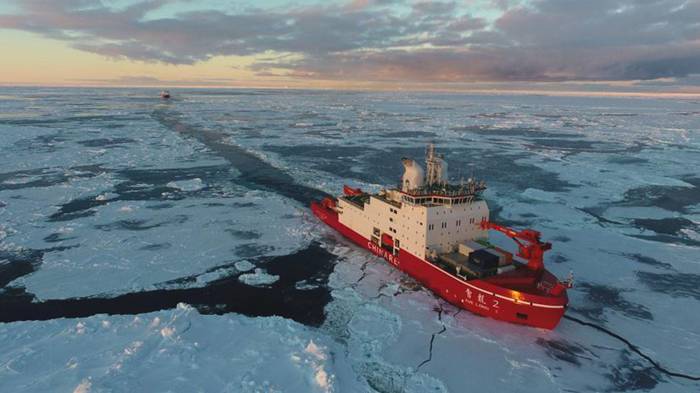China enters the Arctic fight with Russia and the USA

By News.Az
In recent years, China has turned its attention to the Arctic, recognizing the region’s immense strategic and economic potential. As part of this push, China has been rapidly developing its icebreaker fleet, essential for navigating the harsh polar environment and achieving its ambitious goals in the Arctic. In 2024, China took a major leap forward by sending three icebreakers to the Arctic, marking a significant milestone in both technical achievement and global geopolitical strategy.
Sending three icebreakers to the Arctic in the summer of 2024 is a clear indication of China’s broader strategy to cement its influence in the region. The Arctic is seen as a critical area for developing new trade routes that could drastically reduce the time and costs of shipping goods between Asia and Europe. As climate change melts more Arctic ice, new shipping lanes are opening up, and China is eager to capitalize on these opportunities by boosting its infrastructure and presence in the area.
Leading China’s icebreaker fleet is the research vessel Xue Long 2 (Snow Dragon 2), which was commissioned in 2019. Built in just three years, this ship is one of the most advanced and powerful icebreakers in the world. With the ability to break through ice up to 1.5 meters thick, it’s an essential tool for navigating the challenging Arctic environment. The ship is highly maneuverable, capable of moving both forward and backward, making it versatile in various conditions.
Xue Long 2 set off on its multi-month expedition in early July 2024. The journey took it through the Bering Strait, the Chukchi Sea, and the Beaufort Sea, allowing the vessel to conduct extensive research in the central Arctic Ocean. This research is crucial not only for the scientific community but also for the Chinese government, which is keen to gather as much data as possible on the polar environment and the region’s resources.
Another key player in the expedition was the Zhong Shan Da Xue Ji Di (Polar University of Sun Yat-sen). This vessel has a long history, having been built back in 1983 and originally used for oil exploration in the Beaufort Sea. In recent years, it has undergone several upgrades, and since 2021, it has been operated by Sun Yat-sen University. In late July 2024, the vessel embarked on its Arctic voyage and is currently in the Beaufort Sea, near the town of Utqiaġvik, the northernmost settlement in Alaska. The presence of this ship in Arctic waters shows that China is committed to not only developing commercial routes but also conducting scientific research, which is essential for understanding the environmental and climate changes happening in the region.
 The third vessel in China’s Arctic expedition is the brand-new icebreaker Ji Di (Polar), built at the Guangzhou shipyard and commissioned in June 2024. This icebreaker represents the latest in technology and symbolizes China’s dedication to innovation and fleet modernization. The ship can operate autonomously in the Arctic for up to 80 days without needing to dock, making it ideal for long-term research and operations in remote parts of the Arctic. Ji Di is also equipped with modern diesel-electric systems, which make it highly efficient and environmentally friendly—a crucial factor as the world pays more attention to the ecological impact of activities in the polar regions.
The third vessel in China’s Arctic expedition is the brand-new icebreaker Ji Di (Polar), built at the Guangzhou shipyard and commissioned in June 2024. This icebreaker represents the latest in technology and symbolizes China’s dedication to innovation and fleet modernization. The ship can operate autonomously in the Arctic for up to 80 days without needing to dock, making it ideal for long-term research and operations in remote parts of the Arctic. Ji Di is also equipped with modern diesel-electric systems, which make it highly efficient and environmentally friendly—a crucial factor as the world pays more attention to the ecological impact of activities in the polar regions.
But China isn’t the only country ramping up its Arctic presence. Russia, which already boasts the world’s largest icebreaker fleet, continues to modernize and expand its capabilities. In recent years, Russia has added three new nuclear icebreakers to its fleet, solidifying its position in the Arctic. These ships are incredibly powerful, capable of breaking through the thickest Arctic ice. Russia is also actively constructing more icebreakers, fully aware that competition in the Arctic is only going to intensify.
The United States is also stepping up its game in the Arctic. As global warming causes more Arctic ice to melt, the U.S. government is recognizing the need to strengthen its presence in the region. The U.S. Coast Guard recently announced the acquisition of a new icebreaker, Aivik, which was sent to the port of Juneau in Alaska. At the same time, older American icebreakers are undergoing modernization and repairs to ensure they continue to patrol the Arctic and protect U.S. national interests in the region.
In short, China’s expansion of its icebreaker fleet in 2024 is a key part of its broader strategy to assert its influence in the Arctic. China aims to not only develop new trade routes but also expand its scientific and geopolitical footprint in the region. However, despite these significant strides, China faces stiff competition from Russia and the United States, both of which are also ramping up their icebreaker fleets and Arctic operations. In this increasingly crowded and competitive arena, China’s Arctic strategy will require not only technological and scientific breakthroughs but also diplomatic finesse to avoid clashes with other Arctic powers and make the most of the opportunities that lie ahead.

